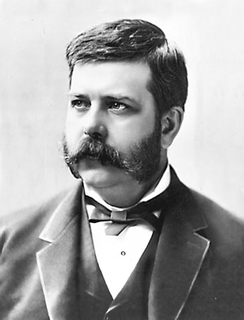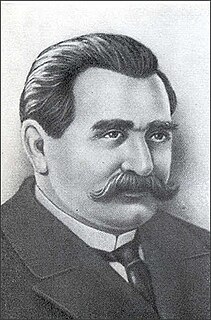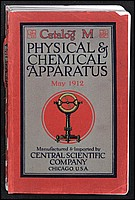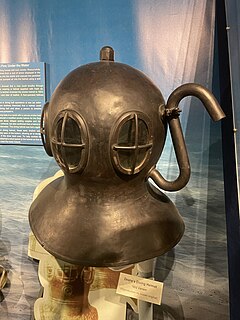Related Research Articles

George Westinghouse Jr. was an American entrepreneur and engineer based in Pennsylvania who created the railway air brake and was a pioneer of the electrical industry, receiving his first patent at the age of 19. Westinghouse saw the potential of using alternating current for electric power distribution in the early 1880s and put all his resources into developing and marketing it. This put Westinghouse's business in direct competition with Thomas Edison, who marketed direct current for electric power distribution. In 1911 Westinghouse received the American Institute of Electrical Engineers's (AIEE) Edison Medal "For meritorious achievement in connection with the development of the alternating current system."

Lewis Howard Latimer was an inventor and patent draftsman. His inventions included an evaporative air conditioner, an improved process for manufacturing carbon filaments for light bulbs, and an improved toilet system for railroad cars. In 1884, he joined the Edison Electric Light Company where he worked as a draftsman and wrote the first book on electric lighting. The Lewis H. Latimer House, his landmarked former residence, is located near the Latimer Projects at 34-41 137th Street in Flushing, Queens, New York City.

Alexander Nikolayevich Lodygin, known after immigration to US as Alexandre de Lodyguine was a Russian electrical engineer and inventor, one of the inventors of the incandescent light bulb.

Clarence Birdseye was an American inventor, entrepreneur, and naturalist, considered the founder of the modern frozen food industry. One of nine children, Birdseye grew up in Brooklyn before heading to Amherst College and began his scientific career with the U.S. government. Among his inventions during his career was the double belt freezer. A biography of his life was published by Doubleday over a half century after his death.

Luther George Simjian was an Armenian-American inventor and entrepreneur. A prolific and professional inventor, he held over 200 patents, mostly related to optics and electronics. His most significant inventions were a pioneering flight simulator, arguably the first ATM and improvement to the teleprompter.

Graybar is an American employee-owned corporation, based in Clayton, Missouri. It conducts a wholesale distribution business for electrical, communications and data networking products, and is a provider of related supply-chain management and logistics services. It is included on the Fortune 500 list of the largest United States corporations.
Paul Wilbur Klipsch was an American engineer and high fidelity audio pioneer, known for developing a high-efficiency folded horn loudspeaker. Unsatisfied with the sound quality of phonographs and early speaker systems, Klipsch used scientific principles to develop a corner horn speaker that sounded more lifelike than its predecessors.

Central Scientific Company was founded in 1900 in downtown Chicago. It was formed out of what was left of the Olmstad Scientific Company.

General Electric Research Laboratory was the first industrial research facility in the United States. Established in 1900, the lab was home to the early technological breakthroughs of General Electric and created a research and development environment that set the standard for industrial innovation for years to come. It developed into GE Global Research that now covers an array of technological research, ranging from healthcare to transportation systems, at multiple locations throughout the world. Its campus in Schenectady, New York was designated a National Historic Landmark in 1975.

John Deane, with his brother Charles, invented the diving helmet and performed diving operations at the wreck of the Mary Rose. They received their education at The Royal Hospital School, Greenwich and were both in attendance in 1812. When he was 14, John joined the East India Company and sailed for seven years.

A sliding door is a type of door is mounted on or suspended from a track for the door to slide, usually horizontally and outside. It is a feature predominately relegated to minibuses and buses, to provide a large entrance or exit for passengers without obstructing the adjacent pathway between the vehicle and any adjoining object or the side(s) of a passenger, and commercial vans, so as to allow a larger unobstructed access to the interior for loading and unloading.
Edge STPs are networking hardware devices embedded with software that performs routing, signaling, firewall, and packet conversion functions. Their primary purpose is to unify networks that use various transports and signaling protocols – such as SS7, SIP, SIGTRAN, TDM, IP, etc. – into cohesive service environments. Unified environments are simpler for telecommunications companies to manage, and also enable them to cost-effectively transition to next-generation networks based on the Internet Protocol (IP).
Estimated to have been founded in the late 1600s, Banksville is a hamlet in the town of North Castle, Westchester County, New York, United States and an area including Stamford and Greenwich, Connecticut. It is an area which had importance for local cottage industries, a boarding school, and local merchants to support its residents in its early days. Banksville was the home of many patriots including veterans who fought in the American Revolution, Civil War and World Wars I and II. Today it remains a vibrant area of neighborhoods that include ancestors from its earliest times.

The Self Winding Clock Company (SWCC) was a major manufacturer of electromechanical clocks from 1886 until about 1970. Based in New York City, the company was one of the first to power its clocks with an electric motor instead of winding by hand.
Peninsula Engineering Group, Inc. (PEGI) was a United States company which was a pioneer in on-frequency microwave and cellular repeaters. From its founding in 1983 until its demise in 2002, the company was a technological leader in the field of low-cost on-frequency repeaters, and was awarded numerous patents. Peninsula Engineering Solutions, Inc. is a successor company that continues to provide both new products and parts based on the PEGI designs. The company went through a few name changes; in 1992 it became "Peninsula Wireless Communications" and in 1995 again changed names to "Repeater Technologies."
The Parris Manufacturing Company of Savannah, Tennessee is an American company that primarily manufactures toy guns.

The Frantz Manufacturing Company located in Sterling, Illinois, is a manufacturer and marketer of conveyor system components and steel ball products used in a variety of applications.

Chad Steelberg (CEO) is an American serial entrepreneur who co-founded AdForce (IPO), 2CAN Media, and dMarc Broadcasting. Most recently, Chad Steelberg co-founded Veritone. along with his brother, Ryan Steelberg, and serves as its CEO.

Demetrius Comino OBE was an Australian engineer, inventor, entrepreneur and philanthropist during the 20th century. He invented the slotted angle steel construction system, Dexion, which became widely used internationally for commercial shelving, storage racking, exhibition stands, accommodation, and for domestic purposes. In 1971 he founded the Comino Foundation, an educational charity.
Homer Clyde Snook was an American electrical engineer and inventor. He developed the Snook apparatus, the first interrupterless device produced for X-ray work.
References
- ↑ Pratt, Verneur Edmund; Selling by Mail: Principles and Practice (1924) New York, NY; McGraw-Hill; 428 pages.
- ↑ Fisher, Clive; Hart Crane: A Life (2002) New Haven, CT; Yale University Press; 567 pages; ISBN 0-300-09061-7
- ↑ Streetscapes/102 Bedford Street; Turning Point for a Greenwich Village Landmark - New York Times
- ↑ Special Libraries: Official Journal of the Special Libraries Association volume 34, no. 4, April 1943
- ↑ Fire alarm – Patent 2999477
- ↑ Multicolor lighting apparatus – Patent 3388245